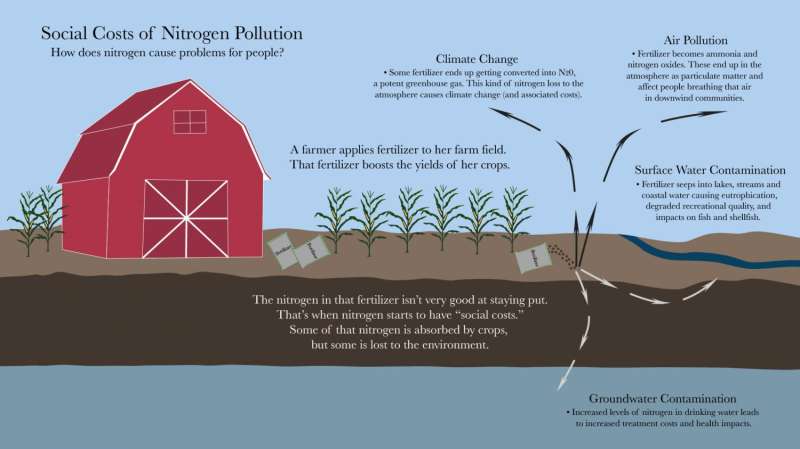How much does that fertilizer REALLY cost?

Humans have more than doubled the amount of reactive nitrogen in the environment since the Industrial Revolution, with adverse consequences that include air and water pollution, biodiversity loss, ozone depletion, water acidification and climate change.
But what exactly do these impacts mean for people and communities, and how can we can figure out where and how much to most effectively reduce the amount of new nitrogen entering the environment?
To adequately account for the cost of nitrogen pollution, researchers from the University of Minnesota Institute on the Environment have proposed a framework that accounts for all of the damages that occur when reactive nitrogen enters our air or water. The framework, published today in the journal Science Advances, provides a valuable tool for estimating the social cost of nitrogen pollution—meaning the dollars-and-cents cost of the trouble it causes—elevating nitrogen accounting to the same level governments now use to account for carbon.
"Scientists and economists have figured out ways to put a price on carbon pollution. Getting a handle on the societal costs of climate change means those costs can be integrated into decisions by agencies and other groups," said study author Bonnie Keeler, IonE program director and lead scientist with the Natural Capital Project, a partnership of the University of Minnesota, Stanford University, The Nature Conservancy and the World Wildlife Fund. "We currently don't have a handle on the costs of nitrogen and as a result the damages caused by nitrogen are not incorporated into decisions."
Tracking nitrogen is tricky because the element takes multiple forms and ends up in diverse places on the landscape—with correspondingly diverse costs. To demonstrate how nitrogen costs can be tracked, the researchers developed a simplified model and applied it to nitrogen fertilizer management in Minnesota. They used data on where and how much nitrogen is applied to cropland, then used the model to track how nitrogen would move into surface and groundwater and the atmosphere, and from there, who it would affect and how much.
"Our work shows that it is possible to get a better handle on the costs of nitrogen and show where investments in mitigating damages from excess nitrogen are most likely to benefit communities," said Keeler. "Ultimately, I'd like to see agencies start incorporating the damage costs of nitrogen into payment schemes, conservation programs, commodity prices or new regulations, just like we are starting to do for carbon. In the meantime we're getting a lot closer to closing the loop on nitrogen impacts."
The University of Minnesota Institute on the Environment is leading the way toward a future in which people and the environment prosper together. For more information, visit environment.umn.edu.
More information: B. L. Keeler et al, The social costs of nitrogen, Science Advances (2016). DOI: 10.1126/sciadv.1600219
Journal information: Science Advances
Provided by University of Minnesota

















